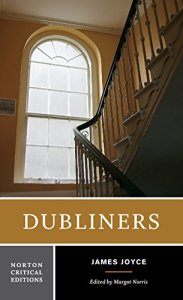
Dubliners
James Joyce
Ireland, 1914
I’m pushing the time, but I did want to write some thoughts on James Joyce’s Dubliners before the end of March. This is my first real experience with Joyce—for book club, of course—and while I can’t say that I’ve found a new favorite (as one of the book club members suggested, perhaps we struggle with Joyce’s realism/naturalism because it hits too close to home), I do appreciate the collection Joyce put together early in his career.
The collection is comprised of fifteen stories, ranging from just a few pages to the nearly novella-length “The Dead.” They are centered primarily on working class Dubliners at the turn of the 19th – 20th century and explore different aspects of everyday life, from youth through adolescence into older age. Some stories dip in and out of seemingly mundane days or events, in which little seems to happen, although sometimes there is more going on under the surface than at first appears.
This is what makes Dubliners, in its way, difficult. The stories themselves are not difficult to read, save perhaps for an archaic turn of phrase or reference here and there (all of which were annotated, and then some in the Norton edition I read), but that is only surface. Joyce leaves out or delays information, making the reader work at times to understand what is going on or what the meaning is. Context is important: Dublin in early 1900s is still under British Imperial rule and the politics and events of the day underline the story throughout. I feel my biggest mistake in reading this collection was not reading up on Dublin and Joyce beforehand, as to do so, would, I think, have both made Joyce’s intentions more intelligible, but also provided an added layer of richness to the stories.
Although seeming disparate stories, a few characters make cameo appearances in a second story, and several themes predominate. Religion, as might be expected for stories from a very Catholic country, pops up again and again, and many characters are heavy drinkers—several implied to be alcoholic. But perhaps the most intriguing is the idea of “paralysis,” which is evidenced throughout. In story after story, characters seem on the edge of change—an opportunity for escape, literal or metaphorical presents itself—but then they don’t take it, seemingly unable to make that decision.
As you might guess from this paralysis, these are not upbeat stories, but there is nevertheless something engaging about them, something that grabs hold. It is perhaps the relatability—the experience of being so close to change only to be frustrated, or of things not quite working out as hoped or expected that we all experience at some point—that both makes it difficult for me to like the stories while also feeling that I’m not done with Joyce, or perhaps even with Dubliners.
I haven’t read anything by Joyce & I think this is the first review I’ve read of Dubliners. If I ever get to read it I’ll do some research as you suggested first.
From what I’ve read, this is more accessible Joyce than his later works, but having an annotated edition was still a great help, not so much for words/terms, many of which I was familiar with (the editor seems to have assumed at least some readers would have no familiarity with some of the religious terminology, for instance), but for the cultural/political context.
A lot of these characters turn up in Ulysses as well which makes it all very neighbourly, I’m glad you ‘enjoyed’ it, I find his writing incredibly rewarding.
Jane, yes, the notes mentioned that several of these characters turn up in Ulysses. I haven’t read that yet, though I do have it tentatively in my “someday” list – I’m glad I read this first, just for those links if nothing else.